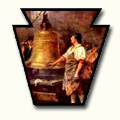| |
208 CLEARFIELD COUNTY - PRESENT AND
PAST
wheat on her back four or five miles to mill, and brought back the flour. Her
brother tied the sack on her back for her. They lived five or six miles east of
Clearfield.
The grain, (threshed with a flail or trampled out by
oxen or horses), had to be gotten directly from the soil after the ground had
been laboriously cleared of logs and brush. The seed was sown broadcast and
worked into the soil with a single shovel plow, among stumps, stobs, stones and
roots, and cut, when ripened, by hand, with a sickle.
When the family wanted meat, bullets had to be moulded
of lead in the bullet moulds, and then, armed with the army musket, game had to
be hunted in the woods. The material for clothing, was either wool from the
sheep's back, washed, carded, spun and woven at home, or linen and tow cloth
made from flax grown in the clearing, and also manufactured into clothing.
Coverings for the feet, generally worn only in winter, had to be fashioned from
the skins of wild animals, made into moccasins, or if made of leather, it had to
be carried fifty miles or more, from the nearest store and then roughly made
into shoes. Small tanneries were an early requirement and were soon provided.
The Factory System. Now we may call up the "butcher"
and "baker" and not the "candlestick maker", but the department store or some
other business place and get anything we want, for money. Since that far off
time, the Industrial Revolution has occurred. This means that instead of
manufacturing things at home, as formerly, everything is now made in factories,
and by machinery to a great extent, instead of by hand, as in the old days. To
be sure, foods still have to be grown from the soil, though machinery lessens
the hand labor still necessary in farming, especially in the West from which
much of our food now comes.
Why People live in the Towns. But the division of
|
|






